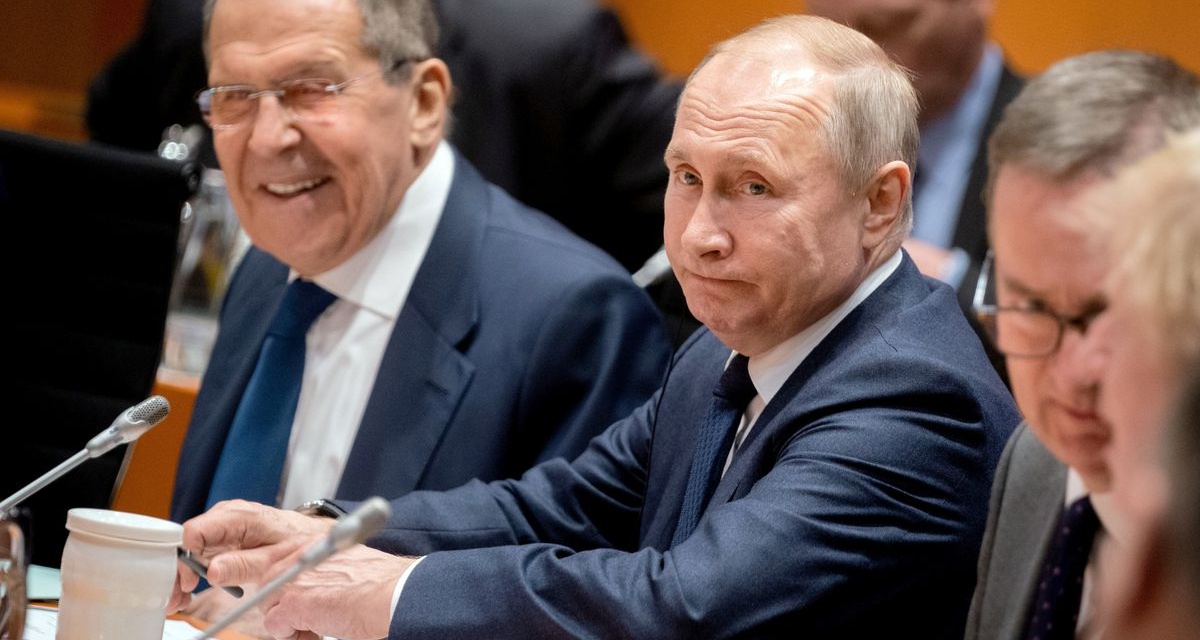Russian Foreign Minister Sergey Lavrov and President Vladimir Putin at the Libya summit, Berlin, Germany, January 19, 2020 (Kay Nietfeld/Reuters)
EA on BBC: Why Shouldn’t Ukraine Give Up Territory to Russia?
EA-Times Radio VideoCast: Zelensky’s “Smartest Move” in Washington
EA-Times Radio VideoCast Special: Zelensky’s White House Triumph
Tuesday’s Coverage: Zelensky-Europe Success at the White House
UPDATE 1639 GMT:
Polish Defense Minister Władysław Kosiniak-Kamysz says the drone that exploded in a cornfield in easter Poland overnight is now believed to have come from Russia.
Russia is once again provoking NATO countries following drone incidents that have taken place in Romania, Lithuania, Latvia.
This is happening at a particularly important moment, when discussions about peace are ongoing. This is happening at a time when there is hope that the war initiated by Russia — a war against the Ukrainian state, but also a war threatening the security of NATO countries — has a chance to come to an end.
Gen. Dariusz Malinowski, Deputy Commander of Armed Forces Operational Command, said, “We don’t have a 100% percent certainty that it was…this specific drone, although we do know the locations from which these types of drones are launched, and they are located on Russian territory.”
He said the drone was propelled by a Chinese-produced engine. It was not clear whether the UAV deliberate violated Poland’s airspace or malfunctioned.
Kosiniak-Kamysz added, “I’ll say one thing that is certain: Russia will never admit to this. Just as it hasn’t admitted to any of the eight incidents in Moldova, three incidents in Romania, three in Lithuania, two in Latvia, or the one drone incident in Bulgaria.”
The Polish Foreign Ministry says it plans to send a protest note to Russia.
UPDATE 1440 GMT:
Poland’s Foreign Minister Radosław Sikorski has responded to the explosion of a drone in a cornfield the east of the country.
Sikorski said there will be a formal protest “against the perpetrator”.
He did name a specific country. However, his spokesperson Paweł Wroński said the UAV was a Russian version of the Iran-made Shahed attack drone.
UPDATE 1435 GMT:
The UK has blacklisted eight individuals or entities involved in “Russia’s attempts to avoid sanctions by exploiting Kyrgyz financial systems and crypto network”.
Those cited include the Kyrgyzstan-based Capital Bank and its director, used by Russia to pay for military goods, and the Grinex and Meer cryptocurrency exchanges, the infrastructure behind a new rouble-backed cryptocurrency token A7A5.
The scheme has moved $9.3 billion on a dedicated crypto exchange in just four months.
UPDATE 1237 GMT:
India’s State oil refiners have resumed purchases of Russian crude after a brief pause because of Donald Trump’s tariffs.
On August 6 Trump announced a supplementary tariff of 25%, on top of a 25% duty on all imports from India already in effect, to be implemented from August 27.
India’s imports of Urals crude had dropped 65% this month. However, Indian Oil Corp. and Bharat Petroleum Corp. bought several shipments in recent days. Deliveries are expected in September and October.
Since Russia’s full-scale invasion of Ukraine in 2022, Indian imports had risen more than 20-fold to more 2 million barrels per day. India is now Russia’s second-largest customer after China.
UPDATE 1113 GMT:
Polish officials assess that an object which exploded overnight in the east of the country was a military drone.
Prosecutor Grzegorz Trusiewicz said authorities have not yet confirmed the origin of the drone. The wreckage will be carefully collected and checked in a laboratory.
UPDATE 0904 GMT:
Ukraine President Volodymyr Zelensky has posted about the latest Russian attacks on civilians and infrastructure:
All of these are demonstrative strikes that only confirm the need to put pressure on Moscow, the need to impose new sanctions and tariffs until diplomacy is fully effective.
Last night, a drone strike on Okhtyrka in the Sumy region injured 14 people. A family with wounded children – 5 months, 4 years, and 6 years old – sought assistance after the attack. In Kostiantynivka, Donetsk region, a glide bomb strike damaged five apartment buildings, and at… pic.twitter.com/TWRPo4Po6F
— Volodymyr Zelenskyy / Володимир Зеленський (@ZelenskyyUa) August 20, 2025
UPDATE 0658 GMT:
At least three civilians have been killed and 34 injured in Russian strikes across Ukraine over the past 24 hours.
Ukraine air defenses downed 62 of 93 drones and one of two ballistic missiles fired by Russia overnight.
The other drones and missile hit 20 locations across the country.
In the Donetsk region in the east, one civilian was murdered and 10 injured. In the Dnipropetrovsk region in south-central Ukraine, one was slain and one wounded. In the Kherson region in the south, one person was killed and three injured, including a child.
At least 14 civilians were injured, including a family with three children aged 5 months, 4 years, and 6 years, in a residential neighborhood in the Sumy region in northern Ukraine.
The casualties were among 16 wounded in more than 140 assaults on 52 settlements.
Ukraine Prime Minister Yulia Svyrydenko posted, “Russia continues to manifest its fears through acts of pure terrorism across Ukraine, once again targeting the homes of families and their sleeping children.”
Russia continues to manifest its fears through acts of pure terrorism across Ukraine, once again targeting the homes of families and their sleeping children.
Among the regions targeted overnight was Okhtyrka in Sumy region, where a residential neighborhood was hit. Thirteen… pic.twitter.com/QkbZjK3evL
— Yulia Svyrydenko (@Svyrydenko_Y) August 20, 2025
The Russians also launched a large drone strike on the Odesa region in southern Ukraine, injuring one person and setting afire a fuel and energy facility.
Port infrastructure in Odesa city was damaged.
❌This is a nightmare. Russian "Shaheds" once again struck peaceful cities last night
Rescuers showed the aftermath of the attack in the Odesa region. The strike hit an energy infrastructure facility — a massive fire broke out, and one person was injured. It was also a heavy… pic.twitter.com/ABKsbUO5aR
— NEXTA (@nexta_tv) August 20, 2025
UPDATE 0654 GMT:
NATO military leaders will confer in a teleconference on Wednesday over the details of proposed security guarantees for Ukraine.
NATO’s top commander, US Air Force Gen. Alexus Grynkewich, will brief the leaders on the Alaska meeting between Donald Trump and Vladimir Putin last Friday.
“People familiar with the matter” say European officials are considering deployment of troops from the UK, France, and around 10 other countries.
Trump has ruled out US forces on the ground, saying on Tuesday morning:
When it comes to security, they’re willing to put people on the ground. We’re willing to help them with things, especially — probably you could talk about by air, because there’s nobody that has the kind of stuff we have, really they don’t have. But I don’t think it’s going to be a problem.
ORIGINAL ENTRY: Under pressure after Monday’s meeting between Ukraine President Volodymyr Zelensky, European leaders, and Donald Trump in the White House, the Kremlin is stalling over the proposal of a face-to-face encounter between Zelensky and Vladimir Putin.
Agreeing to the summit would entail accepting the legitimacy of Zelensky and his Government, which Putin has rejected throughout his 42-month full-scale invasion. Refusal would risk alienating Trump, whom Russia has counted upon to prop up its maximum demands for the capitulation of Kyiv.
On Tuesday, in an interview with state broadcaster Rossiya 24 Russian Foreign Minister Sergey Lavrov said Putin is open to the meeting: “We’re not refusing any kind of work format, neither bilateral nor trilateral. The president has said that repeatedly.”
But he insisted that preparations for high-level summits take time, and he maintained Russia’s demands for Ukranian territory and a weakened and demilitarized Kyiv.
Lavrov as bad cop:
– any Putin-Zelensky meeting has to be "prepared extremely carefully"
– Russia will only agree to a deal that "respects" its security interests
– The "foundations of Ukraine's recognition as an independent state would disappear" if it aligns with the west pic.twitter.com/j3nxRx1LRL
— max seddon (@maxseddon) August 19, 2025
A Venue for the Meeting
The White House said Viktor Orbán, the pro-Putin Hungarian Prime Minister, and Trump had discussed the possibility of talks being held in Budapest.
However, the Hungarians made no statement. Any summit in Hungary could compel authorities to serve an arrest warrant on Putin, wanted by the International Criminal Court over the deportation of tens of thousands of Ukrainian children, unless Orbán completes withdrawal from the ICC.
French President Emmanuel Macron has suggested Geneva as a venue and Switzerland said it could set aside ICC obligations during Putin’s visit.
“This has to do with our diplomatic role, with international Geneva as headquarters of the United Nations,” said Swiss Foreign Minister Ignazio Cassis.
Austria also expressed a willingness to host. Chancellor Christian Stocker said Vienna supported any initiative leading to a just and lasting peace protecting Ukrainian and European security.

